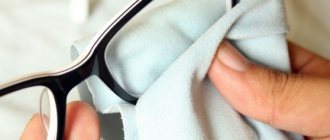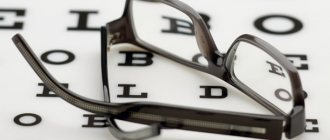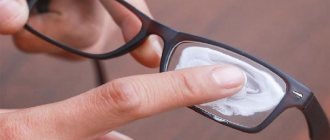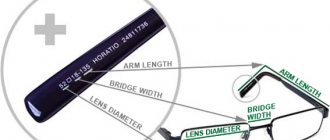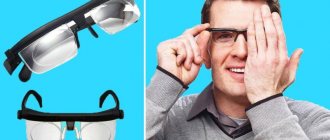An important stage in the life of every person who is faced with a vision problem is getting used to glasses. Regardless of whether a person is using glasses for the first time or has already worn them, he will most likely feel discomfort and experience new unpleasant sensations. It manifests itself in the form of dizziness and slight apparent deformation of objects. The average time to get used to them is up to two weeks. It is important to know how to get used to new glasses faster and with the least discomfort.
Why do they interfere?
Problems that arise after purchasing a new pair are conventionally divided into 2 groups: physical and ophthalmological. The first category is represented by:
- pressure on the bridge of the nose;
- a feeling of compression arising from the arms;
- skin irritation.
The first and second moments eliminate themselves after a few days of constant wearing due to the emergence of habit and adaptation of the frame to the anatomical features of the face and skull. To eliminate the third one, you will have to change your glasses . The material from which they are made caused an allergic reaction. By the way, it can develop over time. Therefore, if you often have pimples on the wings of your nose or where the bridges meet, or there are signs of other irritation, then you need to rush to the optician.
Important! If something like bedsores form on the wings of the nose, then it is worth changing the frame to a more compact one, and the glass, oddly enough, it will sound, to non-glass. Products made from a special polymer material will suit you.
Ophthalmological problems are not associated with a lack of physical habit . This category of unpleasant manifestations includes changes in the perception of the surrounding reality and failures to focus. Examples of such difficulties:
- a change in the distance to the floor, steps or other surface on which a person is located, and the accompanying problems with understanding one’s position in space and with what efforts need to be made to change this position (example: not being able to correctly determine how much one should raise one’s leg, a man trips on a step);
- making objects smaller or larger (example: some people have to take off their glasses when sewing);
- changing the distance to the surrounding environment (example: a tripping person tries to grab an object, but it turns out that it is located a little further than it seems).
Some of these phenomena can be attributed to the consequences of getting used to a particular frame and to certain lenses. A similar development of events cannot be avoided when switching from spherical lenses to aspherical ones , when vision drops by more than 0.75 D (accordingly, new glasses will differ from the previous ones by 0.75 D) and when the cylinder axis changes by more than 10 degrees.
Other unpleasant manifestations indicate incorrectly chosen glasses. For example, for correct selection it is not enough to know visual acuity and the distance between the eyes. The recipe also contains other parameters that are determined during diagnostics.
Checking is also necessary to exclude the presence of ophthalmological diseases that require special lenses . Therefore, if you purchased glasses without a prescription or using an old form, no one can guarantee that unpleasant phenomena such as nausea, dizziness and severe changes in the picture will disappear or at least become less pronounced. If the possibility of an incorrect selection is excluded, then all that remains is to be patient and make efforts to develop the habit as quickly as possible.
Rules for selecting optics
Glasses for correcting astigmatism are quite difficult not only to choose, but also to wear. Quite often, wearing them is accompanied by dizziness, headaches and pain in the eyes. This material will tell you about laser correction of astigmatism.
The intensity of these manifestations depends on the age of the patient: the older he is, the more pronounced these symptoms are, the more he begins to see poorly near or far.
A patient who has been diagnosed with astigmatism undergoes gradual vision correction, which consists of three stages:
- Wearing glasses begins with the use of weak glasses, thanks to which the patient can quickly get used to the glasses.
- Over the course of 3-6 months, addiction occurs, after which stronger glasses are selected. After getting used to the second pair, glasses are prescribed that completely correct astigmatism.
The choice of toric or cylindrical lenses is made by an ophthalmologist strictly individually.
Toric ones, as a rule, are quite difficult to choose and you will have to change several glasses before finding a suitable option. In a situation where, after wearing new glasses for three or more weeks, visual discomfort is felt, it is necessary to urgently seek help from an ophthalmologist or the optical salon where they were purchased. It is possible that the optical correction agent was selected incorrectly. Even after selecting glasses, it is necessary to regularly visit an ophthalmologist to monitor the dynamics of the development of astigmatism and receive recommendations for further treatment. In the future, the patient may need to adjust the lenses by changing them to weaker or stronger ones. Glasses are not just a temporary vision correction, but also an effective way to treat emerging pathology. Read about astigmatism in children and how it manifests itself in this article.
In adults, lens selection is carried out after a complete ophthalmological examination. As a rule, the following checks are carried out:
- visual acuity;
- interpupillary distance.
After assessing these parameters and carrying out additional diagnostic methods, certain lenses are selected for the patient and a prescription is issued for them.
It is better to give preference to glass lenses. The fact is that this material is much more durable, less damaged and not susceptible to scratches. A significant difference is also the higher efficiency in correcting astigmatism. Plastic is lighter and cannot break, but it is the softness of the material that contributes to the rapid appearance of scratches, which leads to a decrease in the ability to adequately correct vision. Therefore, they need to be replaced much more often, and the amount of distortion that occurs in them is much higher.
For the treatment of ophthalmic diseases, it is best to choose glass lenses due to their higher efficiency.
The importance of choosing the right frames should not be overlooked. Its edges should slightly touch the temples, and the lower part should be located no lower than the line, which is conventionally drawn at the level of the upper part of the nostrils. The eyes should be in the middle. It is better to avoid purchasing large lenses or frames due to some discomfort in the periphery while wearing. Find out how to distinguish myopia from farsightedness here.
The basic rule is that the center of the spectacle lens should be on the same plane as the center of the pupil.
Despite the fact that glass lenses are better at correcting vision, when choosing glasses for children suffering from astigmatism, the choice is made towards plastic. The fact is that safety, lightness, ease of wear and lower cost make them more practical and convenient
This choice is quite logical and the activity of pediatric patients is considered first. Frequent falls and active games can lead to injury. Also, the weight of glass lenses is much higher, so they can constantly slip, thereby disrupting the process of vision correction and disrupting the normal development of the nasal septum.
Are there ways to get used to it?
Unpleasant sensations can be minimized. To do this, follow the following rules and recommendations:
on the first day, limit the time of use;- with each subsequent day, increase the wearing time;
- when using it for the first time, let your eyes get used to the new sensations, just sit motionless in them for a few minutes;
- then complete the tasks that the glasses are designed to help solve (if you are nearsighted, try to look at objects on the street; if you are farsighted, read the text);
- take off your glasses before going up the stairs, but don't hesitate to use the railings;
- if difficulties are associated with the amount of light penetrating through the glass, buy lenses with tinted or reflective coating;
- Do your daily activities while wearing glasses (do this even if your daily tasks start to take more time).
Getting used to new glasses
The need to adapt to new optical products, including sunglasses, may be due to the following factors:
- changing parameters in a recipe;
- optics prescribed for the first time;
- new design of spectacle lenses;
- different frame shape.
The adaptive abilities of each person are individual, including visual ones. They determine the duration of the habituation period. Before we learn how to get used to glasses, we’ll tell you what problems a person may encounter at the very beginning of using new optical products.
How long will it last?
The process is purely individual. It is impossible to give an exact answer, since the state of health, the correct fit of the frame and the type of lenses used are unknown . Moreover, the second parameter - the location of the center of the lens strictly in front of the pupil - is not always checked even in optics.
Important! Specifics in this matter are excluded, but there is an approximate, rather wide range. It varies from several days to 2 weeks.
Correct selection
Glasses for children should be selected only in specialized optical shops. Poor quality frames and spectacle lenses can impair vision.
An important point is that when choosing glasses, parents should take into account the child’s opinion and purchase those that he will like. This will help him overcome psychological discomfort among his peers and perceive them as his distinctive feature, and not something shameful.
The selection of children's glasses has its own specifics. In the case of an adult, first choose glasses lenses, and then a frame for them. With children it's the other way around.
Selection of glasses
The most difficult step is choosing a frame. It should be comfortable to wear, durable, hold the lenses well, fit in size, and not rub or press. Then lenses are selected for it. Their choice should also be taken very carefully, since the health of the child’s eyes depends on them.
Spectacle lenses can be made of plastic or glass. However, it is not advisable to use glass lenses in glasses for a child. Despite a number of advantages - such lenses are not scratched, have high optical characteristics, they can be unsafe.
Children lead an active lifestyle and often fall or bump into other children while playing. If dropped, the glass lenses of glasses can easily break and the child risks eye injury.
It is better if the lenses of children's glasses are made of plastic - acrylic or polycarbonate. Currently, another material for lenses has appeared - Trivex, which is even lighter than plastic.
The use of such lenses is more preferable for children. They are lightweight, glasses with them will not cause discomfort to the child, and they are safer than glass ones. In addition, they are highly durable (especially those made of polycarbonate) and if they do break, they do not form sharp fragments.
If you have significant astigmatism, you can use glasses made of plastic with a high refractive index. The use of such material makes it possible to significantly reduce the thickness of the lenses and the weight of the glasses.
However, the disadvantage of plastic is its softness. Scratches easily appear on the surface of lenses, which impairs their optical properties. Therefore, glasses for children should have a special hardening coating. It increases the resistance of spectacle lenses to scratches and extends their service life.
How to “defeat” astigmatic glasses?
To shorten the adjustment process, you should consider ordering frames made to suit your needs . This behavior is rational if at least 1 item below corresponds to what is indicated in the glasses prescription:
- the spherical component is equal to or greater than ±4.0 D;
- the eyes have different visual acuity or the size of the cylindrical component;
- astigmatic lenses are prescribed for the first time;
- the cylindrical component is equal to or greater than 1.0 D.
If it is not possible to order a unique frame, then when choosing a ready-made frame, rely on the following recommendations:
go to the optician in the morning;- do not order glasses if you are undergoing therapy with potent drugs or are pregnant;
- take with you your old prescription and old glasses (lenses);
- try not to choose frames that are radically different in size and clearance from the version you wore before;
- opt for high refractive index lenses.
In general, you need to be prepared for the fact that the process of addiction will drag on . This cannot be avoided; this is a feature of astigmatic glasses. Moreover, in their case the principle applies: the higher the degree of astigmatism, the more difficult it is to adapt. The average time it takes to form a habit varies from a few minutes to a month.
Important! For older patients, the process is delayed even more, so they need a gradual transition to a new type of glass: first they take a product with smaller diopters, and then gradually come to the required value.
Advantages and disadvantages
The advantages of spectacle correction include:
- ease of use;
- relatively low cost.
- embarrassment when wearing glasses due to aesthetic discomfort;
- glasses help reduce the viewing angle and thereby disrupt spatial perception, which is a big disadvantage for drivers. If the frame is selected incorrectly, headaches, fatigue, or a significant decrease in performance may occur;
- It is difficult to combine wearing glasses with active recreation or playing sports;
- With the help of glasses it is not always possible to achieve the highest levels of visual acuity;
- If glasses fall, they can cause serious damage to the eyeball;
- There are certain difficulties with the selection of lenses. The fact is that if they are chosen incorrectly, disease progression occurs (astigmatism, myopia, hypermetropia).
What not to do?
- do not bend the frame trying to adapt it to your face;
- do not buy glasses according to the old prescription and finished products that do not take into account any of your indicators except for visual acuity (these are usually sold in markets and in dubious shops);
- after the first failures, refuse a new pair for a long time (the first week you need to resort to glasses as often as possible, otherwise the habit will simply have nowhere to come from);
- ignore the increasing severe pain and dizziness.
If the symptoms not only do not disappear over time, but also intensify, then this is a reason to contact a specialist . Perhaps an error was made during the selection or manufacture of glasses.
Subscribe to our Social networks
How to distinguish glass from plastic in glasses?
Why a table without a tablecloth is not good
Problems encountered when starting to wear new glasses
When selecting new glasses for patients, the Optic-Center ophthalmology clinic warns about a possible feeling of discomfort at the beginning of wearing them. Temporary visual impairment and other reactions cannot be ruled out:
- Distortion of lines and contours of objects;
- Inadequate assessment of distance to objects;
- Increasing or decreasing objects in size.
Depending on the type of glasses, a certain reaction occurs. If the patient suffers from myopia, the distance will seem smaller than in reality. When buying glasses with positive diopters, the effect changes in the opposite direction.
When buying astigmatic glasses, there is a difficult process of getting used to, and choosing them is not easy. They create discomfort when the optical power increases. If you can’t get used to such optics, then the specialists of our ophthalmology clinic recommend contact lenses with a toric design or laser vision correction.
With bifocal glasses, everything is also complicated. They are prescribed to correct presbyopia. They lack an optical zone for intermediate distances, making them difficult to get used to. There is rapid eye fatigue.
In people with presbyopia, correction difficulties can be aggravated by untimely contact with an ophthalmologist. Such people get used to correcting refraction by moving the objects being studied further away from the face. This method is effective as long as your arms are long enough; as a result, precious time is wasted and for correction, ophthalmologists prescribe optics with strong diopters, which increases the period of adaptation.
Getting used to new glasses is accompanied by physiological reactions:
- Rapid fatigue of the visual organs;
- Dizziness;
- Painful sensations in the eyes;
- Headache.
Our ophthalmologists warn patients about the adjustment period and the difficulties ahead. They also give specific recommendations to shorten the period of getting used to new glasses.
To wear or not to wear?
The most common diseases that require glasses in childhood are astigmatism, myopia, and farsightedness.
Wearing glasses should not be neglected under any circumstances, because this is an important part of treatment. However, it is worth remembering that the result of treatment, namely the child’s vision in the future, largely depends on whether the spectacle correction is chosen correctly!
- For farsightedness, glasses are usually prescribed for constant wear. In childhood, uncorrected farsightedness that exceeds the age norm contributes to the development of amblyopia (lazy eye syndrome) and convergent strabismus.
- As for myopia, most often children need glasses for distance, and many also for near (when myopia exceeds 5-6 diopters). But glasses, alas, do not always correct vision to a high level, which is associated with dystrophic and other changes in the membranes of the myopic eye.
- For astigmatism, glasses with cylindrical lenses with a certain wearing mode are prescribed. The fact is that with astigmatism, glasses can be prescribed for constant wear or only for performing any exercises at close range.
- Contact lenses for your child should only be selected by a doctor based on the results of diagnostics performed using modern equipment;
- You should purchase high-quality and proven lenses only from a specialized clinic.
- It is equally important to store and process contact lenses correctly; the period of wearing and storage should not be exceeded.
- Children are strictly prohibited from sleeping in lenses, as this can lead to the development of severe corneal diseases.
- Do not forget also that the lens is a foreign body for the eye, so it is necessary to regularly consult an ophthalmologist. Children who wear glasses also need visits to an ophthalmologist!

